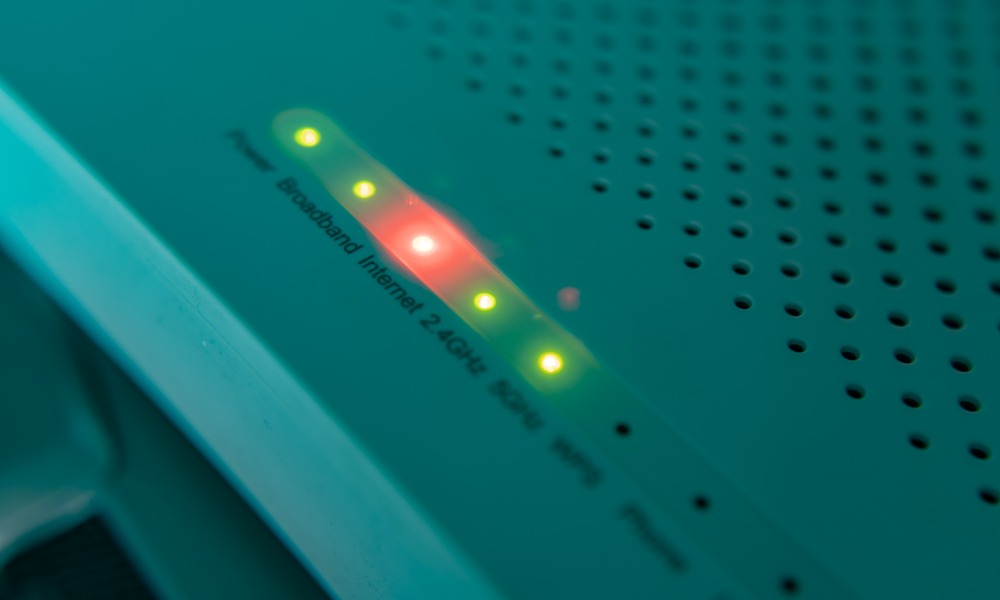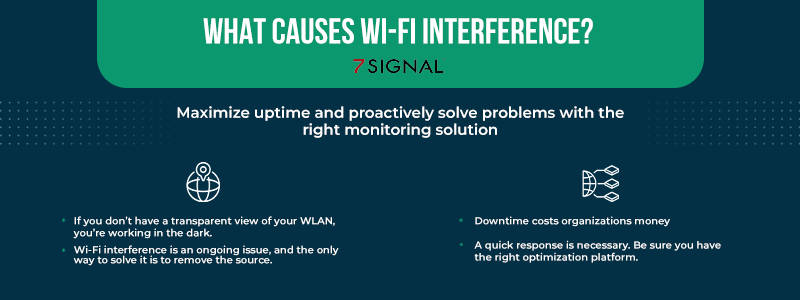
Blog

Maximize uptime and proactively solve problems with the right monitoring solution
What makes a wireless local-area network (WLAN) so useful—a lack of wires—is also what makes your network vulnerable to interference. The air is shared by all transmitting devices, and they can cause low signal strength, a slow connection to the internet, slow file transfers between Wi-Fi devices, issues connecting to Bluetooth, and dropped connections. Wireless access points sharing the same channel can also interfere with each other. Even a microwave running in the kitchen of a nearby office or home can cause problems.
For businesses that depend on a reliable Wi-Fi connection, Wi-Fi interference can cause a great deal of disruption. From video conferencing to VoIP telephone systems, the cloud platform you use to store and access data, or your eCommerce store, a dependable connection is a must. In addition, internet downtime is costly. A 2014 study estimated the cost at $5,600 per minute for larger businesses and up to $427 per minute for smaller companies. You can only imagine what that means at today’s prices.
The list of things that can interrupt your Wi-Fi signal is extensive, and some of the reasons might surprise you. No matter the cause, it’s a problem that must be solved. In this blog post, you’ll learn what causes Wi-Fi interference and the Wi-Fi connectivity solutions that can keep your business and your home network reliable and consistent.
Just what is Wi-Fi interference?
It’s important to understand that Wi-Fi is not your internet connection. It’s a method of connecting to your router without a cable. Wi-Fi uses the same radio frequencies—2.4 GHz for older equipment and 5 GHz for newer, dual-band routers. While this is a boon to homes and businesses because it uses radio waves, Wi-Fi is vulnerable to interference from other devices using the same frequency range.
Wi-Fi interference causes loss of speed as well as dropout and latency issues. It’s a common problem that leads to many a technical support call and email. So what causes Wi-Fi interference? Read on.
What causes Wi-Fi interference?
All sorts of things can interfere with your Wi-Fi: You’ll notice your Bluetooth earbuds won’t pair, uploads and downloads take unreasonably long, and your wireless connection drops intermittently. You might also notice that your connection is slow when someone else’s device is being used on the same network or even those within the normal range of your router will have problems. So what’s causing all this havoc?
Building materials
While they aren’t the only culprit, the material used in your home or office building can block radio waves or weaken the signal via electromagnetic interference. These materials include:
Metal
Consider metal the ultimate in signal-blocking material. It makes it difficult for radio signals to penetrate because metal easily conducts electricity. This means rather than passing through, the electromagnetic waves of Wi-Fi are absorbed. This action is not limited to building materials—metal blinds, doors, furniture, and walls can disrupt your Wi-Fi signals.
Concrete walls
Concrete is one of the thickest building materials and Wi-Fi signals have a difficult time penetrating them. Couple that with the fact that concrete is often reinforced by metal, and you have the perfect recipe for signal interference.
Windows and tinted glass
This one might surprise you. Glass is certainly not as thick as walls, they still present a problem for your WLAN. Great for lighting, windows can interfere with your Wi-FI signal by reflecting it, and low-emissivity windows that have metallic film can reflect the signal to a greater degree than a clear window. And the same thing goes for tinted glass.
Plaster and metal lath
If you have plaster walls and ceilings in your home, it’s probably reinforced with wood lath. Plaster used in commercial construction uses metal laths. Either wood or metal when coupled with the typical 5/8-inch thickness of plaster walls can considerably reduce or entirely block a Wi-Fi signal.
Anything that impedes the free travel of radio signals can interfere with your Wi-Fi connection. However, drywall, the most common interior building material in use today, has the smallest impact on your wireless signal. In addition to building materials, a number of devices are a part of what causes Wi-Fi interference.
Frequency interference: when signals cross paths
The list of devices that can cause Wi-Fi interference is extensive, but here are some common offenders:
- Other wireless networks.
- Wireless devices such as speakers, cordless Wi-Fi phones, and surveillance cameras.
- Microwaves, which operate on the 2.4 GHz spectrum—the same as many Wi-Fi networks, creating interference while in use.
- External monitors within the 2.4 GHz band.
- Digital satellite dishes.
- Christmas tree lights and fish tanks might look pretty, but they are on the same frequency as your
- Wi-Fi network and cause problems not only with the signal, but also connectivity.
- Additional problems come from connected devices with poorly shielded cables.
Now that we’ve answered the question of what causes interference with Wi-Fi, what can be done about it?
WLAN solutions that maximize uptime
The waves of Wi-Fi signals can’t be seen, so what’s causing issues is a bit of a mystery. Wi-Fi transmits and receives over unlicensed radio frequency bands that are free for public use. This is great, but it also means there’s a lot of sharing over the 2.4 GHz and 5 GHz bands. The only cure for Wi-Fi interference is to remove the source—hard to do if the problem is a wall or a door. And a diagnosis can be quite tricky. That’s why wireless network monitoring is vital.
When Wi-Fi issues happen, quick action is vital. You need a transparent view into both the health and strength of your Wi-Fi network at all times. This means implementing a platform that measures connectivity from the perspective of a device. This gives you wireless network insights that might be missed with just hardware-based monitoring.
With monitoring, you can solve connection issues before anyone even notices. Your help desk can focus elsewhere while challenges are being addressed via monitoring your network at the edges, where device and user experience really matter. You’ll get a complete picture with insights into coverage, congestion, interference, and more with the right WLAN monitoring solution.
Wi-Fi interference happens. It’s how you deal with it that matters. It’s time to put yourself in the driver’s seat with the fast insights that allow better control over the wireless experience to maximize your network, and develop the Wi-Fi experience to meet the needs of your organization while reducing costly downtime.
Get the clear view you need
Wi-Fi experience monitoring improves experience and performance across your entire organization. It’s a proactive solution to common problems that put you in control with reactive monitoring tools.
7SIGNAL’s wireless experience monitoring platform gives you continuous information about the health of your Wi-Fi network. The Sapphire Eye® can be installed on your network devices so that you’ll be able to solve issues before any users notice.
Learn more about our platform and how it makes a significant impact on the health of your WLAN. Contact the 7SIGNAL team today.
7SIGNAL® is the leader in wireless experience monitoring, providing insight into wireless networks and control over Wi-Fi performance so businesses and organizations can thrive. Our cloud-based wireless network monitoring platform continually tests and measures Wi-Fi performance at the network's edges, enabling fast solutions to digital experience issues and more robust connections for mission-critical users, devices, and applications. Learn more at www.7signal.com.